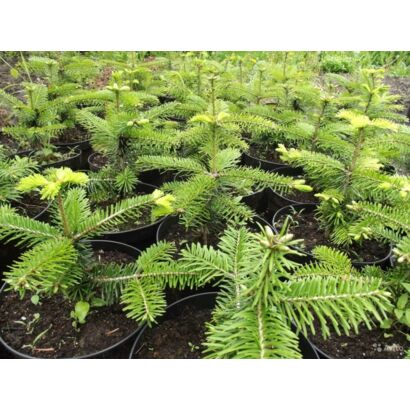Siberian fir
Purpose: ornamental gardening
Crown: narrow conical, pointed
Pine needles: dark green
Frost resistance: – 35°C
Regions: all regions
Origin: Russia
Siberian Fir (lat. Ábies sibírica) — a tree of the pine family, the most common type of fir in Russia. It grows mainly in mixed coniferous forests next to cedars and spruces. Less common in light forest and deciduous forest.
In the wild, Siberian fir grows in the northeast of the European part of Russia, in the Urals, in Siberia, Arkhangelsk, Ivanovo, Kostroma and Nizhny Novgorod regions, as well as in the Republic of Mari El, Chuvashia, Tatarstan, Kazakhstan.
The cultivated (garden) form of fir is often used in park improvement in the northern and central European parts of Russia.
Variety advantages: decorative appearance, frost resistance.
Appearance
The treein the wild grows up to 30 meters in height. Crown – narrowly conical shape. Root – rod with deep-reaching lateral processes. Trunk – cylindrical, ribbed below. Branches – thin, often sinking to the ground. Bark – dark gray, smooth, with veins that are filled with fragrant resin ("fir balsam"). A tree lives in the forest for 200-300 years.
Garden form – is more compact in size. At the age of 20, the height reaches 9 meters, by the age of 80-100 – 22 m. The life expectancy of a tree in landscape gardening is about 100-150 years. Up to 10 years, fir grows slowly.
The needles of Siberian fir are dark green, shiny, not prickly, up to 3 cm long. With a pronounced coniferous aroma.
Cones of dark purple color are formed on the shoots of the previous year, while growing vertically upwards. By the time of maturation, they increase to 7-9 cm in length and change color to light brown. The seeds are arranged in pairs in the axils of the scales. In September-October — cones crumble, scales and seeds fall off.
Firs growing in the forest begin to produce seeds at 60-70, in open areas — at 30.
Application. Thanks to a beautiful narrow-pyramidal crown with a sharp top, which is preserved even in old trees and high frost resistance, Siberian fir is very popular in landscape design and arrangement of landscape gardening areas, especially in the northern regions.
The most attractive appearance of the tree is in the spring, when it is covered with brownish-red or bright yellow inflorescences and young purple cones.
Ornamental firs are planted in small groups in the form of alleys or hedges. And also one by one.
Immunity. The plant is often infected with fir hermes (a type of aphid). If a specific white coating is found on the lower part of the needles, it is necessary to immediately treat the plant with special preparations.
Growing conditions. Siberian fir is frost- and wind-resistant, shade-tolerant, loves fertile, moderately moist soils and relatively high air humidity. At the same time, the tree is sensitive to gas pollution and soot, and does not grow above permafrost.
Beware of fakes and infected planting material, purchase Siberian fir seedlings in specialized nurseries.
